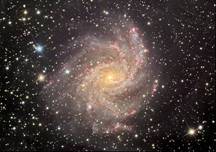Once upon a time a cowherd fell deeply in love with a woman weaver. They would see each other so often that the cows were neglected and the spinning wheel scarcely turned. The father of the weaver became so enraged by this slacking off (even in the name of love) that he banished the couple into the sky.
According to this Korean legend, the couple could meet only once a year on the seventh day of the seventh month. Only then could they cross the river because of the magpies. Magpies in Korea flocked like crazy in July - and to atone for their role in separating the lovers, flew up to the stars to build a bridge across the river. Only then could the couple meet on the backs of the magpies. In Korea, children were taught to stone any magpies they saw not helping build that bridge.
Look for Vega high in the east and Altair lower in the southeast after dark. And check out the lovers on July 7th to see them shine happily.
-













